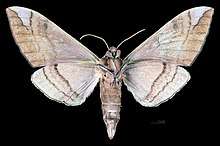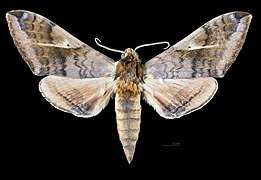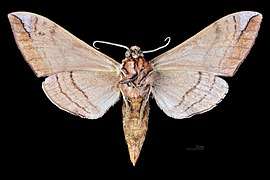Clanidopsis
Clanidopsis is a genus of moths in the family Sphingidae, containing only one species Clanidopsis exusta, the white-streaked hawkmoth. The genus was erected by Walter Rothschild and Karl Jordan in 1903 and the species was first described by Arthur Gardiner Butler in 1875.
| Clanidopsis | |
|---|---|
 | |
| Male upperside | |
 | |
| Male underside | |
| Scientific classification | |
| Kingdom: | |
| Phylum: | |
| Class: | |
| Order: | |
| Family: | |
| Genus: | Clanidopsis Rothschild & Jordan, 1903 |
| Species: | C. exusta |
| Binomial name | |
| Clanidopsis exusta | |
| Synonyms | |
| |
Distribution
Is found from northern Pakistan (Margalla Hills) and north-western India, eastward along the southern slopes of the Himalayas to central Nepal and neighbouring parts of Tibet and Hubei in China.[2]
Description
The wingspan is 70–96 mm. It is similar to Clanis species, but the proboscis is much shorter and the forewing is broader and not falcate apically. The forewing underside is lacking a black streak posterior to the discal cell and the hindwing upperside is lacking the black basal patch.
 Upperside of male
Upperside of male Underside of male
Underside of male
Biology
The larvae have been recorded feeding on Indigofera species in India.[3]
References
- "CATE Creating a Taxonomic eScience - Sphingidae". Cate-sphingidae.org. Archived from the original on 2013-04-19. Retrieved 2011-11-01.
- Pittaway, A. R.; Kitching, I. J. (2018). "Clanidopsis exusta (Butler, 1875) -- White-streaked hawkmoth". Sphingidae of the Eastern Palaearctic. Retrieved December 14, 2018.
- Butler, Arthur Gardiner (1876). "Revision of the Heterocerous Lepidoptera of the family Sphingidae". Transactions of the Zoological Society of London. 9 (10): 511–644.
| Wikispecies has information related to Clanidopsis |